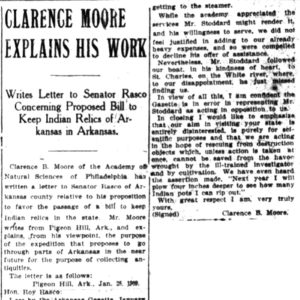calsfoundation@cals.org
Clarence Bloomfield Moore (1852–1936)
Clarence Bloomfield Moore was an amateur archaeologist from Philadelphia, Pennsylvania, who investigated hundreds of Native American mounds and archaeological sites in several Southern states, including Arkansas. He published lavishly illustrated volumes, based on his excavations, which have been reprinted recently.
Clarence Moore was born on January 14, 1852, in Philadelphia. He was the son of Bloomfield Haines Moore and Clara Sophia Jessup. His father was the head of the prosperous Jessup & Moore Paper Company of Wilmington, Delaware. His mother was a prolific writer, mostly of books on etiquette and advice to young women. Clarence had two sisters, Ella and Lillian, both of whom married Swedish aristocrats.
As a child, he was educated in Philadelphia, France, and Switzerland. He entered Harvard University in 1869, graduating with an AB degree in 1873. Moore spent the next five years traveling the world. This lifestyle ended with the death of his father in 1878, after which Moore was appointed president of the paper company. He devoted most of the 1880s to managing the company and accumulating a personal fortune.
A lifelong bachelor, he had developed an interest in archaeology as early as the 1870s, and this field, along with photography, eventually became his consuming passion. In the late 1880s, he turned management of Jessup & Moore over to others and devoted the next three decades to investigating mounds and other archaeological sites in the southeast United States.
Moore outfitted a steamboat, the Gopher, to travel rivers and other waterways. Stopping at archaeological sites, his paid workmen would dig for pots and other artifacts. His typical schedule was to travel and dig in the late fall, winter, and early spring, spending the summer at his home in Philadelphia. He spent those summers writing reports on his research that the Academy of Natural Sciences of Philadelphia published in oversize, well-illustrated volumes. His steamboat pilot normally spent the summer exploring waterways to find sites and obtain permission from landowners for the next season’s digging.
Moore visited Arkansas several times between 1908 and 1913, traveling and digging in hundreds of archaeological sites along the Arkansas, Black, Little, Mississippi, Ouachita, Red, St. Francis, Saline, and White rivers, as well as Bayou Bartholomew. His work in the state drew attention to the elaborate pottery made by the Indians of Arkansas. Although his methods were crude by today’s standards, his publications still have immense value as the only records available for many of the sites. His records have also been useful for modern archaeologists who have done additional work at sites he visited, such as Parkin and Rose in Cross County, Kent in St. Francis County, Crenshaw in Miller County, and Menard in Arkansas County.
After several years of declining health, Clarence B. Moore died on March 24, 1936, in St. Petersburg, Florida. He is buried in Woodland Cemetery in Philadelphia, Pennsylvania.
For additional information:
Aten, Lawrence E., and Jerald T. Milanich. “Clarence Bloomfield Moore: A Philadelphia Archaeologist in the Southeastern United States.” In Philadelphia and the Development of Americanist Archaeology, edited by Don D. Fowler and David R. Wilcox. Tuscaloosa: University of Alabama Press, 2003.
Moore, Clara Jessup. “Ancestry of Clarence Bloomfield Moore, of Philadelphia.” National Genealogical Society Quarterly 28 (March 1940): 1–8.
Morse, Dan F., and Phyllis A. Morse, eds. The Lower Mississippi Valley Expeditions of Clarence Bloomfield Moore. Tuscaloosa: University of Alabama Press, 1998.
Weinstein, Richard A., David B. Kelley, and Joe W. Saunders, eds. The Louisiana and Arkansas Expeditions of Clarence Bloomfield Moore. Tuscaloosa: University of Alabama Press, 2003.
Jeffrey M. Mitchem
Arkansas Archeological Survey
 Clarence Moore Article
Clarence Moore Article 




Comments
No comments on this entry yet.